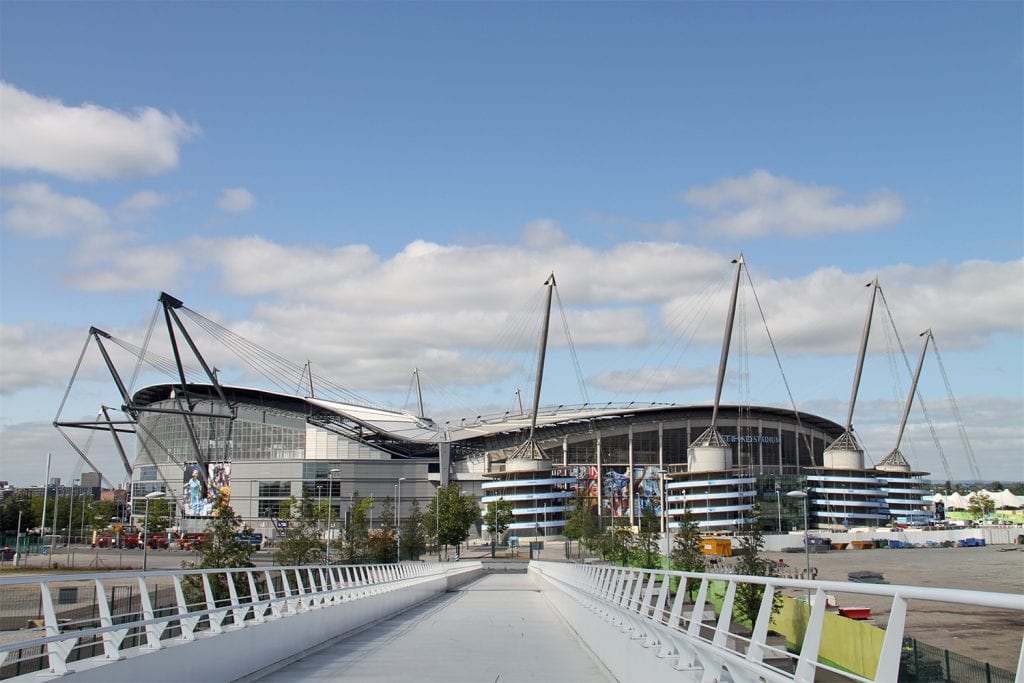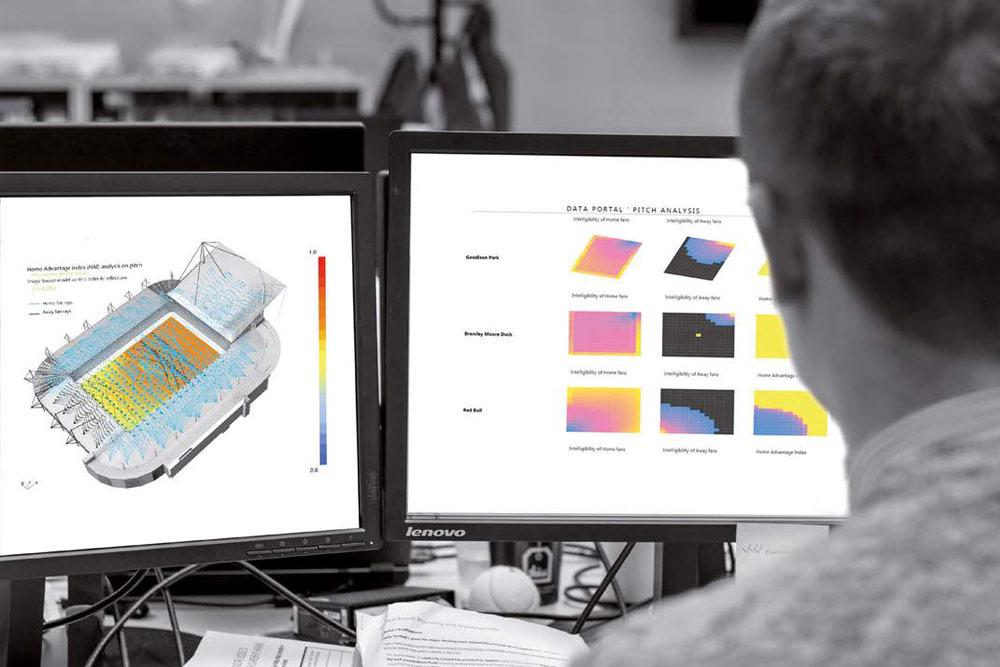The future of football
How the beautiful game can come back stronger
The Sport & Entertainment industry has experienced its worst hit in over 75 years. Right now, everyone is busy addressing the short-term impacts of Covid-19 and understanding what it means for them. For football clubs, the immediate focus has been on revitalising business, putting staff back to work, getting players on the pitch and letting fans watch games on television. Of course, we assist our clients wherever possible in achieving such pressing aims; however, we also see this time as an opportunity for clubs to look further into the future in considering how the game and their business could be shaped.
Here, as the Director of Buro Happold’s Sport & Entertainment team, I look at the medium term – next season – before jumping ten years ahead in considering what might await football, its stadiums and fans.
Next season
What will going to a match be like for the 2020/21 season? I don’t believe that anyone really knows, so at Buro Happold we’re not going to zone in on one thing. Our strength lies in bringing everything together to deliver the outcomes that clubs desire. In my experience, great outcomes aren’t usually created by one singular intervention.
I’ve seen several companies moving quickly to stake a place in advising clubs on how distributing fans to accommodate social distancing using various algorithms and visualisations. This may be the way that it goes but there are multiple complications that would need to be thought through. In a parallel sector, I’ve heard arena operators talk of not wanting to stage concerts with distributed audiences and a much-reduced capacity because they not only feel that it will be a poor experience that fans will not want to pay for but also fear damage to their brand. The desire for people to get together is just that – a desire to get together. It is not a desire to sit in a mostly empty venue, separated from everyone else. Moreover, maintaining that separation at such emotionally charged events presents its own problems. When a football team scores a crucial goal, how on earth can stewards stop fans from embracing each other?
Then again, perhaps we won’t be going to a match at all next season. That isn’t to say that clubs won’t be able to create a special matchday experience. Our consultants have been exploring the use of Zoom – or similar – to connect fans and players should closed-door games persist. Audible support and feedback can only make competing in an empty venue more intense and enjoyable for players. A livelier atmosphere on the pitch will enrich the experience for fans, even while the closest they can get to the action is cheering from their sofas.

Buro Happold has created 3D models of more than 70 stadium bowls, including most of the Premier League and Bundesliga. We are examining how to use this information in convincingly distributing fan noise throughout the stadium. Temporary screens behind the goals could heighten this connection with the players. After all, you don’t have to be at the ground for the excitement of a game to get you jumping around. Indeed, my wife still mentions the time I nearly broke my foot by kicking the sofa when Daniel Sturridge equalised for England against Italy in the 2014 World Cup. I can imagine such visible support being used by broadcasters in cutting to a montage of celebrating online fans rather than showing the stands as usual. Perhaps this will lead to a custom form of something similar to Strava, the app typically used to track running and cycling. A “Fan Strava” could – with permission – use phones to track spectators in terms of both movement and decibels.
This thinking all revolves around trying to limit what might be considered as inauthentic. For a TV audience, I’m sure that the broadcasters could fill the stands with virtual people making virtual noise. But would that really be satisfying? Do we want someone to turn on the Mo Salah chant after he scores a goal? In my view, technology that creates a raw but real environment is far more likely to succeed than flash but fake. Indisputably, the integrity of the viewing experience is crucial to broadcasting and this has a direct knock-on effect to club revenue.
We don’t really know where the guidelines will take us so let’s not be afraid to have a suite of options on the table. Considering us all two metres apart is just one of many possible futures. Perhaps the science will progress towards people being allowed in clusters if they can all prove they have been tested and given the all-clear? We’ve heard much talk of the dangers presented by mass gatherings of 40,000 people, but maybe multiple groups of, say, 100-500 people wearing face coverings will eventually be considered an acceptable risk. I’ve really no idea, but it’s hard to imagine that we will all be quite so stringently separated in a year’s time, whether at work, on public transport or in a stadium. The message may become one of “minimise contact, wear protection”. We will, as the well-worn refrain goes, be guided by the science. With that in mind, clubs should keep open minds to make the best of whatever comes around.
The next year may serve as a catalyst for stadium evolution just as significant as the move to all-seater venues.
Ten years ahead
Here we are, then, the year 2030. I’ve lost count of presentations that start with the insistence that the only thing that is certain is change – I feel that this statement often deters us from thinking about what won’t change and what we don’t want to change. While the football landscape has shifted over the decades – three points for a win, the Bosman ruling, all-seater stadiums, the incredible rise of broadcasting money, England winning a World Cup penalty shoot-out – at heart the game has changed little. The controversy over the introduction of VAR demonstrates how this sport doesn’t tend to move quite as fast as some other aspects of our lives.
That all being said, the next year may serve as a catalyst for stadium evolution that proves to be just as significant as the move to all-seater venues. In the Buro Happold Sports team, we believe that people will always want to enjoy the unique feeling of being entertained as part of a crowd and that football without fans is simply not the same. But maybe a few key points should be considered as clubs make plans:
- Technology within the ground may develop to allow fans who are not at the game to contribute. In my view, this is not the same as sound being amplified or “pumped in”. This can clearly benefit mega-clubs with global fan bases; it could also be a plus for smaller clubs by allowing them to sell virtual tickets without the capacity constraints of a modest stadium. Realistically speaking, this may even begin in the next few months.
- The merging of broadcasting technology and actual experience has its pitfalls. For example, Premier League fans were critical of how the “VAR experience” is more geared to the TV viewer than the fan in the stadium. However, technology doesn’t have to be the enemy of the pure experience – imagine a 360-degree screen, designed into a new stadium at the rear of the bowl or within the roof, with live images of the fans who can’t be at the game. In fact, we’ve already helped to design this for the Mercedes-Benz Stadium in Atlanta.
- The perspective on broadcasting having a detrimental effect on attendances may change. The current financial model in the EFL Championship is not sustainable, so I suspect a greater openness to broadcasting may develop. Many fans would love to watch every game that their club plays but can’t make the away matches for reasons of either time or affordability. Perhaps we will soon be able to buy tickets to watch away games on TV; the fear that this will stop people travelling to games could be addressed by using some of the money derived from broadcasting to fund travel and subsidise ticket prices for those who want to go. Let’s not forget that some people are not physically able to attend games so there is a positive inclusivity aspect here.
- Going further, stadiums can look to exploit what the TV can’t provide. This is not just the raw feeling of being physically present but the whole experience. Perhaps the biggest success of Tottenham Hotspur’s stadium is the concourse design. It’s a refreshing movement away from the old model of focusing on the 10% of guests in hospitality to make matchday revenue – that other 90% will spend big if the experience is good enough.
- The aforementioned Fan Strava might develop, with a voucher for the club shop being given to the most active and vocal fan in the ground for each game. Again, this adheres to the principle of encouraging genuine participation rather than faking it.
- Some of these technological developments may lead towards a reduction in optimum stadium size for each club, with the emphasis on quality rather than quantity. It’s often forgotten that many of us go to watch football in half-empty stadiums at the best of times, so wouldn’t it be great to design venues that can expand and contract in some way? Movable components, such as the sliding pitch at Tottenham, can allow stadiums to shake off their rigidity.
- In the coming years we expect the competition for global viewers and digital impressions to increase still further, with broadcasters preferring certain venues over others. This isn’t just about technology – the return of standing to our grounds is an example of a development that isn’t futuristic by any means. Dortmund’s famous “Yellow Wall” – an immense grandstand that holds 24,454 spectators – contributes to the viewing experience of all fans, not just those at the game. Imagine the viewing experience at a ground with 360 degrees of lower tier standing.
- And, of course, climate change hasn’t gone away. Stadiums need to be more sustainable in their creation and operation.
In summary, any football club planning to either develop their stadium or build a new one needs to look ahead and design in flexibility to meet changing circumstances. Despite the current prevailing air of uncertainty, opportunity most definitely exists and so we need to be able to design for outcomes. Accordingly, the capability that Buro Happold has developed to model potential outcomes is now more crucial than ever because one thing is certain – stadiums will continue to strongly influence the revenue, results and reputation of all clubs.


